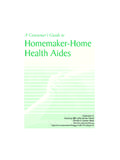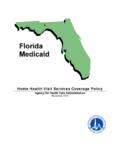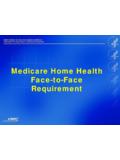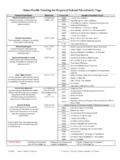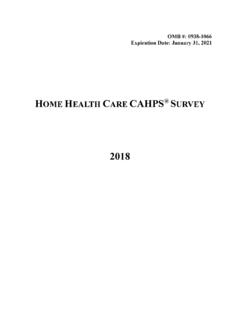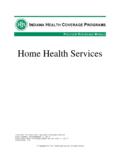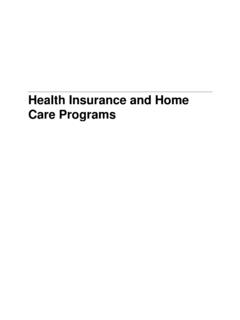Transcription of A Handbook to Assist Home Health Care Providers …
1 A Handbook to Assist home Health Care Providers in Emergency Preparedness Planning home Health EMERGENCY PREPAREDNESS Office of Public Health Preparedness Michigan Department of Health and Human Services 201 Townsend St. Lansing MI 48913 Phone 517-335-8150 Fax 517-335-9434 This Handbook is prepared by the Office of Public Health Preparedness with grant funding from the Department of Health and Human Services (HHS) Office of the Assistant Secretary for Preparedness and Response (ASPR) Hospital Preparedness Program Cooperative Agreement Number 6U3 REP090218-02-02.
2 CREDIT STATEMENT This material is adapted from the home Care Emergency Preparedness: A Handbook to Assist home Care Providers in Emergency Preparedness Planning produced by the HCA Education and Research subsidiary of the home Care Association of New York State with HHS funding awarded to Health Research Inc. on behalf of the New York State Department of Health . HCA Education and Research 194 Washington Avenue, Suite 400 Albany, NY 12210 Phone 518-426-8764 Fax 518-426-8788 Table of Contents Chapter 1- Introduction and Overview .. 1 Chapter 2- Michigan Emergency Preparedness Background.
3 4 Chapter 3- Elements of Planning .. 6 Chapter 4- Step1: How Prepared is the Agency? .. 9 Hazard Analysis Worksheet .. 9 Hazard Vulnerability Planning Priorities .. 12 Agency Preparedness Assessment and Planning 13 Chapter 5- Step 2: Develop the Agency s Plan .. 20 Business Continuity .. 23 Communication .. 24 Community Partnerships .. 25 Demobilizing the Response .. 26 Education .. 26 Evacuation and Mandatory Evacuation .. 28 Immunizations .. 29 Infection Prevention and Control .. 29 Isolation and Quarantine .. 30 Memorandums of Understanding .. 30 Mental Health .
4 31 Pediatric Patients .. 31 Resource Management .. 32 Safety and Security .. 32 Sheltering .. 32 Surge Plan .. 35 Transportation Plan .. 35 Waivers .. 36 Chapter 6- Step 3: Test and Evaluate the Agency s Plan .. 38 After Action Report and Improvement Plan .. 39 Additional Resources .. 41 Appendices .. 42 A: Sample Emergency Preparedness Policy Language .. 42 B: NY Department of Health s home Care/Hospice Preparedness Guidelines .. 52 C: Agency Emergency Contact List .. 55 D: Staff Call Down List .. 56 E: Patient Emergency Plan .. 57 F: FEMA Evacuation Guidelines.
5 62 G: After-Action Report/Improvement Plan Template .. 63 home Health Emergency Preparedness 1 | P a g e Chapter 1 Introduction and Overview The purpose of this Handbook is to Assist Michigan home care agencies in writing, augmenting, and evaluating their emergency preparedness plans. An emergency plan, in the most basic sense, is a guiding document that outlines in detail the systems and protocols which an organization has in place to: ensure the safety of staff and patients, operate within the larger emergency management system, and maintain continuity of services to patients during and after an emergency.
6 The protocols outlined in this Handbook are best-practices recommended through consultation with Providers working in the home care field. The type of emergencies covered by an emergency plan could include natural incidents like flooding, hurricanes, or winter weather conditions; infectious disease outbreaks; man-made disasters or accidents which cause widespread exposure or dangerous conditions; and others outlined further in this Handbook . For home care Providers , like all Health services organizations, preparedness is a critical part of the operation for ensuring patient care and safety, staff security, continuity of business operations and its reputation.
7 While at this time, Centers for Medicare & Medicaid Services (CMS) proposes ( Condition of participation: Emergency preparedness) a basic framework and guideline structure for emergency planning, the most effective preparedness and response plans are comprehensive, agency-wide initiatives that provide explicit protocols requiring all organizational staff and departments to work together under a shared understanding and collaborative effort. Format This Handbook has several sections, including background on the Office of Public Health Preparedness (OPHP) role in emergency preparedness, a section to Assist Providers in assessing the strength of their preparedness plans, an in-depth look at various protocol areas that should be considered in plan development, and tools for ongoing evaluation of a plan s effectiveness.
8 The four basic sections are as follows: Mission of OPHP- This section provides information on the basic core framework for medical and public Health emergency planning in the State of Michigan. Proposed CMS regulations, together with best practices developed from Providers in the field; make for the elements of a comprehensive emergency plan directing an organization s response and post-incident activities to ensure safety, continuity of care, and continuity of business operation. Step 1: Hazard Vulnerability or Risk Assessment. Preparedness assessment is the process of determining the various risks and threats an agency and patients might face.
9 It involves estimating the impact of both historical and potential incidents on the business and clinical operations. home Health Emergency Preparedness 2 | P a g e Step 2: Plan Development. This is the most in-depth and extensive section of the Handbook , outlining the various factors that an agency should take into consideration as it develops or improves its emergency plan. This section of the Handbook is divided into a series of topical themes that include such important planning elements as business continuity, surge capacity policies, expectations during an evacuation order, sheltering information, community partnerships, infection control and more.
10 Agencies should read this section carefully and then use the draft policies, available in Appendix A of this Handbook , for model protocol language for use in addressing these topics within the agency s emergency plan. Planning templates are available in the appendices section. Step 3: Plan Evaluation. Routine evaluation is a critical part of making sure the agency s plan reflects its ability to safely and effectively respond to and recover from a disaster. This section provides information and tools to Assist Providers in plan evaluation, including protocols for paper review and making updates to the emergency plan, drills, and use of after-action reports (AARs).










